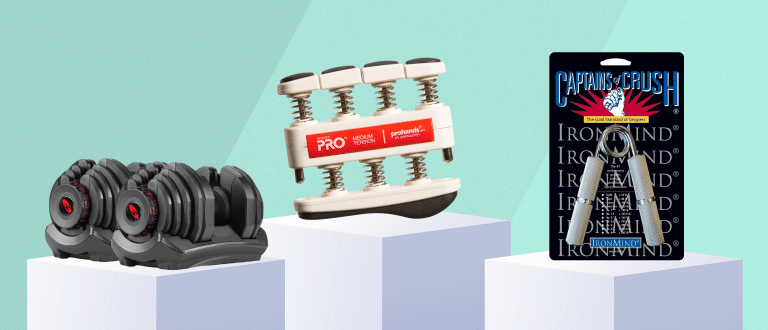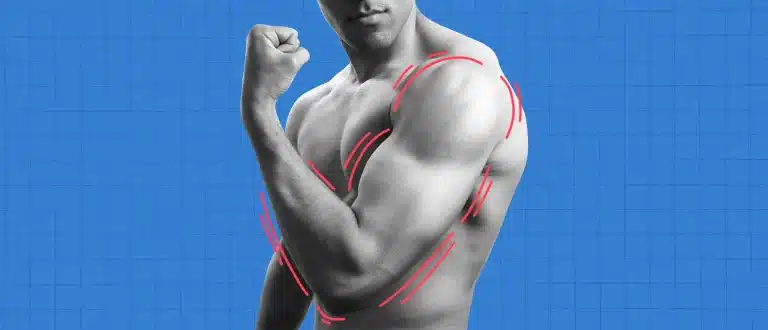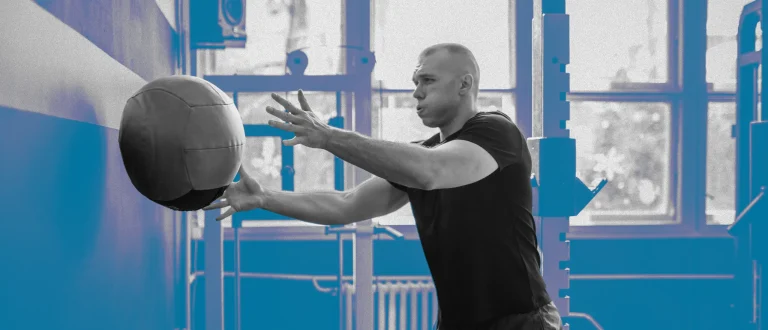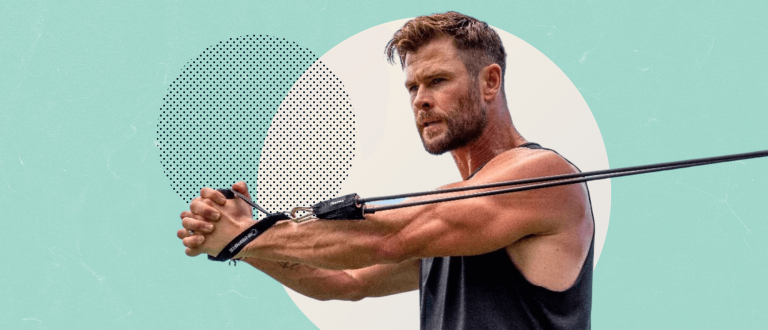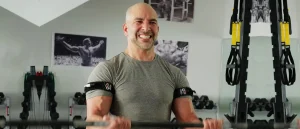The Top 7 Exercises to Improve Grip Strength, According to a Personal Trainer
30-Second Takeaway
- Grip strength is key for maintaining functional strength and mobility as you age.
- A stronger grip is linked to better health, overall strength, and a reduced risk of cardiovascular disease, diabetes, and all-cause mortality.
- To improve grip strength, focus on exercises that challenge your forearms and hands like compound exercises using free weights, hammer curls, sled pulls, and rope climbs.
When it comes to snagging PRs on big lifts—like deadlifts—overall strength matters, but it might be your grip strength that’s holding you back. A strong grip is key for pushing yourself in the gym, which means bigger strength and muscle gains.
But more importantly, you depend on your grip all day long. Whether you’re holding on to your dog’s leash for dear life, or dead set on carrying all your groceries in one trip, you need a strong grip. Grip strength is essential for building and maintaining functional fitness, or your ability to move safely and efficiently throughout the day.
Grip strength also says a lot about how healthy you are (1). A strong grip is key for a longer lifespan and a better healthspan (or the quality of life in those extra years). The weaker your grip strength, the older your biological age, per a study published in the Journal of Cachexia, Sarcopenia, and Muscle (2). A weak grip has also been linked with a higher risk of cardiovascular disease, diabetes, and all-cause mortality (3, 4, 5).
And unless you’re working on your grip strength, you’re probably losing it, according to celebrity personal trainer Daniel McKenna, NASM CPT. “One study found that the average grip strength loss is 2.2 percent per year (6). That may not seem like much, but after five years, you’re already at an 11 percent loss,” he explains.
Ready to level up your grip, stat? Here’s McKenna’s approach for strengthening your grip from every angle.

ABOUT THE EXPERT
Daniel McKenna is a celebrity fitness trainer, founder of the Irish Yank Society, and creator of the Irish Yank Fitness App. With nearly a decade of experience, the Irish Gaelic football athlete turned celebrity trainer is on a mission to help as many people as possible find joy in daily movement. His unique approach to fitness combines foundational training techniques with positive reinforcement to help clients see and feel noticeable changes.
The Best Exercises to Improve Grip Strength
Nearly any exercise variation where you’re hanging from a bar, holding or moving weight with your hands, or making use of your hands and fingers—like squeezing a ball or pulling a rope—can improve hand and grip strength. Here’s a few of McKenna’s favorite exercises for a stronger grip.
Heavy compound exercises
The simplest way to challenge your forearms and improve grip strength is lifting heavy. This is where compound exercises excel. McKenna points out that compound exercises—like back squats, rows, chest press, and deadlifts—involve more muscle groups to get the job done, meaning you can handle heavier loads. Heavy barbells, kettlebells, and dumbbells will put your grip to the test, and simultaneously improve it as you progress the load over time.
To further challenge your grip strength, try mixing up your grip during deadlifts or rows by making use of a neutral grip (palms facing your midline), overhand grip (palms facing towards you), underhand grip (palms facing away from you), or mixed grip (one towards you and one away). Different grips will call on different muscles in your forearms and hands, strengthening your grip from different angles.
Barbell biceps curls
Barbell curls aren’t only good for massive bicep gains, they’ll build your grip, too. McKenna loves that barbell curls are ideal for challenging your biceps with even more weight than dumbbells. With barbell biceps curls, your biceps are doing the major work of moving the weight, but your hands, wrists, and forearms are taxed as they fight to control the movement. Slow down the eccentric phase (or the lowering portion) of this move, it’ll help you build even more strength and size in both your biceps and your forearms.
How to:
- Start by standing up straight, core engaged, shoulders down and back, with a slight bend in your knee. Hold a barbell with an underhand grip (palms facing away from you) with the back of your psalm resting on your thighs.
- Contract your biceps to curl the barbell up to your shoulders, keeping your elbows locked into place at your sides.
- Pause for one second, holding the barbell at the top of the movement.
- Lower the barbell with control.
- Repeat.
Hammer curls
Hammer curls look a lot like bicep curls, just with the dumbbells shifted to a neutral grip. This change may appear minimal, but it puts more work on your forearms (which are key for a stronger grip).
How to:
- Start by standing up straight, core engaged, shoulders down and back, with a slight bend in your knee. Hold dumbbells at your sides with arms extended. Rotate your palms to face your thighs, with your thumbs facing forward, and your shoulders relaxed.
- Keeping your grip neutral, curl the dumbbells up until your thumbs are near your shoulders.
- Pause for one second, holding the dumbbell at the top of the movement.
- Lower the dumbbells with control.
- Repeat.
Pro tip: To further challenge your forearms, try Zottman curls, a bicep curl that involves pausing at the top of the curl and rotating your palms away from you before lowering. This rotation is key to developing forearm strength.
Sled pulls
Sled pulls are a great way to challenge your overall power, strength, and stamina. Plus, they’ll target your back, shoulders, biceps, and the whole battery of grip muscles (forearm, wrist, and hand muscles). Sled pulls are unique in that they demand a full range of motion to get the sled from point a to point b, and they’re typically done for distance or time—maximizing both mechanical tension and time under tension—a combination that can help boost gains (7).
How to:
- Load up a sled with a challenging weight you’re confident you can move for a solid distance, then position yourself so you’re facing the handles (or ropes) connected to the sled, and grip the handles.
- With your feet shoulder-width apart, core engaged, and upper body upright, push back with your hips and bend at the knees to get into an athletic squat stance.
- Drive with your hips and pull the handles up and back right by your ribs to pull the sled towards you.
- Take a few backward steps to reset the movement.
- Repeat.
Rope climbs
Few exercises build grip, arm, and upper body strength like climbing a rope. It’s simple, it’s effective, and it will kick your butt. A standard rope climb makes use of both your arms and your legs to power up the rope, to really challenge your grip McKenna encourages you to use your arms as much as possible. Most gyms or CrossFit gyms now have climbing ropes at easy access. If you don’t have access to a rope, try towel pull-ups with an alternated grip to mimic the act of climbing.
Rope slams
Battle rope exercises are great for strengthening your grip, as battle ropes tend to be thicker than a standard barbell or dumbbell. That extra width (and weight) of the rope forces your forearms and hand to work harder to hold onto the rope. Bonus: Rope slams will build your coordination, agility, and cardiovascular strength, too. Aim to get through three to four sets of 30 seconds each, increasing the time (or your effort) to level up the intensity.
How to:
- Start standing with your feet approximately hip-width apart, holding each end of the battle rope in your hands with an overhand grip (your thumbs should be on top).
- With control, raise both ends of the rope and then simultaneously slam them down.
- Repeating this movement, slam both ropes down simultaneously with as much force as possible, maintaining your foot position and keeping both feet glued to the ground.
Dead hangs
Pull-ups will increase your grip strength; but if you aren’t quite there yet, a dead hang will do. Dead hangs are incredible for shoulder health, and can help improve your posture. They’re also one of the best ways to improve your grip, specifically your support grip which helps you hold onto things. Simply hang from a pull-up bar as long as possible. Aim to hang for 15 seconds and work your way up to longer holds.
How to:
- Use an overhand grip (palms facing away from you) to grab onto a secure overhead pull-up bar with hands about shoulder-width apart. Avoid jumping to grab onto the bar as gaining control of your swinging body can add an extra layer of challenge. Instead, place a step, bench, or box underneath the bar if you need a lift.
- If using a step, bench, or box, step off so you’re hanging onto the bar with your arms fully extended, and body hanging below. If the bar is low enough that your feet are touching the ground, bend your knees to bring your shins and feet behind your body.
- Try to keep your upper body relaxed, with your arms straight (no elbow bend), but engage your core, glutes, and shoulders for stability.
- Hold for 10 to 30 seconds, working up to 90 seconds with practice.
Farmer’s carry
Farmer’s carries are simple. Just grab a weight in each hand, hold it at your sides, and walk. The aim: walk as long as you can while carrying the weight. Like dead hangs, farmer’s carries specifically strengthen your support grip. After loading up farmer’s carries nice and heavy you’ll be ready to carry groceries for hours.
How to:
- Start by standing up straight, core engaged, shoulders down and back, with a slight bend in your knee. Hold dumbbells at your sides with arms extended. Rotate your palms to face your thighs, with your thumbs facing forward, and your shoulders relaxed.
- Walk forward with control, keeping your core engaged and upper body active.
- Load this exercise heavy and aim to go anywhere from 30 to 100 yards to build strength, or lighten the load and go for 60 seconds plus to build hypertrophy and endurance.
What is Grip Strength, Exactly?
“Simply put, grip strength refers to the ability to hold things in your hands,” says McKenna. From hanging on a pull-up bar to nailing a perfectly firm handshake, grip strength is the measure of the muscular strength or the maximum force your forearms and hands can generate to grip onto things.
While having a strong grip in general is important, McKenna points out that there’s actually three types of grip that should be on your radar:
- Crush Grip: Your ability to make a fist, and squeeze or crush something in your palm. “You need a strong crush grip for things like boxing or juicing a lemon,” says McKenna.
- Support Grip: Your support grip determines how long you can hold onto something. You use your support grip when you’re carrying heavy grocery bags, or doing farmer’s carries or pull-ups in the gym.
- Pinch Grip: “Pinch grip is the strength of your fingers,” explains McKenna. You rely on your pinch grip when squeezing a ketchup packet or holding onto a pencil or pen.
“Crush grip and support grip are actually fairly similar, but you can think of crush grip as a sprint and support grip as a marathon,” says McKenna. In other words, crush grip is a quick, forceful squeeze, while support grip is holding that squeeze for time. “If you work on the first two types of grip strength, you’ll have an easier time with your pinch grip,” he adds.
Benefits of Grip Strength
Improving your grip comes with a load of benefits. A strong grip has been linked to:
How to Measure Grip Strength
There’s only one way to know for sure if your grip is slipping: Measure it. Physical therapists and personal trainers measure hand grip strength with a grip strength dynamometer, which is a good tool to test where you’re at and track grip strength gains. (You can snag one on Amazon for around $25). Average grip strength scores vary by age, sex, and your dominant hand, but the best numbers to compare to is your own over time.
That said, you don’t need to measure your grip strength to feel the improvements of building it. You might notice you can squeeze out a few more reps on the pull-up bar, that your grip strength is no longer the limiting factor during barbell rows, or that carrying your laundry up and down the stairs isn’t the mission it once was. All of the above are grip strength wins, per McKenna.
References
1. Bohannon,, R. et al. (2019). Grip Strength: An Indispensable Biomarker For Older Adults.
2. Petersen, M. et al. (2022). Grip Strength is Inversely Associated With DNA Methylation Age Acceleration.
3. Leong, D. et al. (2015). Prognostic Value of Grip Strength: Findings From the Prospective Urban Rural Epidemiology (PURE) Study.
4. Mainous, 3rd, A. et al. (2015). Grip Strength as a Marker of Hypertension and Diabetes in Healthy Weight Adults.
5. Garcia-Hermoso, A. et al. (2018). Muscular Strength as a Predictor of All-Cause Mortality in an Apparently Healthy Population: A Systematic Review and Meta-Analysis of Data From Approximately 2 Million Men and Women.
6. Forrest, K. et al. (2012). Patterns and Correlates of Grip Strength Change With Age in Afro-Caribbean Men.
7. Figueiredo, V. et al. (2018). Volume for Muscle Hypertrophy and Health Outcomes: The Most Effective Variable in Resistance Training.
8. Sallinen, J. et al. (2010). Hang-Grip Strength Cut Points to Screen Older Persons at Risk for Mobility Limitation.
9. Wu, D. et al. (2022). Association Between Handgrip Strength and the Systemic Immune-Inflammation index: A Nationwide NHANES 2011-2014.




